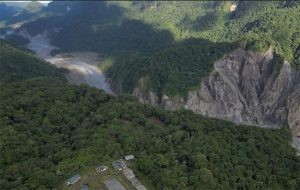
By Geisha Kowlessar-Alonzo / TT Guardian
PORT SPAIN
EnergiesNet.com 02 21 2022
Wednesday’s blackout all but crippled the Point Lisas Industrial Estate with most of the plants having to shut down. Tens of millions of US dollars were lost in production, which cannot now be recovered, resulting in a loss of money, and in particular, foreign exchange to the country.
In fact, almost two days after the incident not all the plants were back into full production because the power failure meant the petrochemical plants would have to be restarted safely, which takes time.
Fitzroy Harewood, president of the Point Lisas Industrial Estate Association (PLEA) which represents the petrochemical companies admitted that many of them were down because of the loss of electricity and this cost millions of US dollars.“Yes the estate was disrupted and a number of plants came offline, some remained with partial operations based on their own in-house generation and over the last day or two normalisation activities are ongoing.” Harewood told the Sunday Business Guardian.
He added, “T&TEC would have disrupted the operations of the estate and some of the plants are still in the process of coming back up or fully back up.”
Herewood revealed most of the plants on the estate were reliant on T&TEC for their power to operate.
On Wednesday, Trinidad was plunged into a nationwide blackout that went on for more than 12 hours before power was restored to the entire country. T&TEC has so far, said the problem emanated from a technical fault and that led to a cascade of events.
Prime Minister Dr Keith Rowley has since called for an investigation as the blackout hurt the economy and is thought to have contributed to a significant number of criminal events including murders, robberies and even the fire-bombing of a house.
Asked to quantify the extend of the losses the president of PLEA was reluctant but admitted it was in the millions of US dollars.
Telecommunications challenges
Not only was the Point Lisas Industrial Estate severely affected, but the telecommunications infrastructure was also placed under a lot of pressure. On Wednesday, hundreds of thousands of people relied on their mobile phones and data to contact their loved ones and keep abreast with what was happening.
But how reliable is T&T’s digital infrastructure system especially in a time of crisis?
Digicel told the Sunday Business Guardian that for most of its customers, the network delivered on its promise to ensure reliable connectivity despite the challenging situation.
According to the company, with hundreds of cell sites strategically placed throughout the country, Digicel quickly activated its robust crisis management plan when the outage occurred.
It explained this included customer communication, technical updates, site management and logistics coordination to mitigate the impact.
“The result was that most customers had continuous access to their mobile voice and data services but the company recognises that many people had their service impacted by reduced coverage, especially as the time frame of the power outage extended,” Digicel said.
Further, it noted that “with an all hands on deck approach,” Digicel’s technical team and contractors worked behind the scenes into the wee hours of the morning installing and refuelling generators, monitoring batteries and network performance and managing infrastructure that was at the risk of going offline.
Digicel CEO Abraham Smith said, “I always say that the real strength of our company is in the people. We have the best employees who care deeply about our customers.
“When the blackout occurred, we immediately ensured that all of our core network elements were properly working and that the major generators and back up power supplies kicked in. Overall, our batteries held out well and our core network was solid. “
Smith said Digicel deployed three sets of teams throughout the country; one team ensured that the generators and batteries at the various sites kicked in and where they did not, technicians visited these locations to manually turn them on.
The second team deployed temporary generators in hub locations to ensure that key areas maintained service quality and the third team monitored fuel levels, and refuelled generators as needed, Abraham added.
He also noted that these workers “left their families behind and worked in the darkness,” adding that due to their efforts, more than 65 per cent of Digicel’s sites maintained their integrity throughout the blackout.
According to the company, from 2020 to present, Digicel has invested approximately TT$8m directly into expansion costs of its mobile network, which provides coverage for 98.2 per cent of the population.
The investments include the installation of battery backup and generators on major cell sites.
Smith added that as more customers joined the Digicel network, the company would continue to make investments into even better technology and machinery to ensure that “come what may,” they would stay reliably connected.
The Sunday Business Guardian also reached out to TSTT regarding and according to the company, TSTT has engineered most of its network to maintain service in adverse events including those triggered by loss of commercial power.
It explained that this was part of TSTT’s disaster business contingency planning.
The company added that TSTT’s main network sites were equipped with standby generators which were fuelled and maintained as part of TSTT’s regular preventative maintenance schedules.
“The generators kick in when commercial power is lost and have the capacity to provide 24 hours of run time powering our network equipment,” the company said.
Additionally, it said, most of its remote mobile sites were equipped with standby batteries engineered to provide at least four hours of reserve capacity in the event of a loss or interruption in commercial power.
“We currently have 610 locations with varying technologies, (2G,3G, and 4G). Some of those locations have back up generators and some have battery back up power. While designed to last up to four hours, based on load, the back up capability can be less.
“Given that the outage lasted over four hours, some of those locations went into outage and customers would have experienced challenges accessing voice and data services on the mobile network,” TSTT said.
Noting that some customers would also have experienced, “for a short period of time, difficulty accessing data on their mobile devices,” TSTT explained it alleviated this challenge by implementing a temporary APN bypass.
“Although that was regularised quickly, some customers would not have had service if they were in proximity to locations where the battery back up power ran out.
“Our team actively monitored the situation and remained in close contact with the utility provider and fuel partners throughout the ordeal,” TSTT said.
It added that by 1 am on February 17, 9 per cent of its nodes were back in service and by 10 am approximately 100 per cent of its cell sites were on air.
In 2010, TSTT said, it invested in a “world-class” Data Centre which was the first in the region to achieve TIA-942-B (Rated 3), DCOS maturity level 3, and SOC Type 2 international standards certification.
TSTT added that it operated the only data centre in the region with this level of certification for facilities and operations.
Further, the company said, in 2017 it launched bCloud, the region’s first and only VMware Cloud Verified service, making it possible for local enterprises to benefit from an on-island cloud service without compromising the quality and availability that may be derived from an international provider.
“On February 16, the redundancy we engineered performed as designed. Despite the loss of commercial power, all Data Centre and Cloud Services were not impacted. There was 100 per cent uptime and all systems remained fully functional,” TSTT said.
Manufacturing impacted
The manufacturing sector also took a hit during the blackout.
President of the Trinidad and Tobago Manufacturing Association (TTMA) Tricia Coosal said the majority of manufacturers were negatively affected by the unplanned outage.
She noted that while some small and medium sized manufacturers had generators which mitigated the impact, there were challenges, negative fallout and loss of income for SMEs.
“Some entities’ machines had to be restarted or products on the production line had to be discarded as a result of the long wait time for the return of electricity,” Coosal explained.
Additionally, she said, members also reported loss of income due to a loss of shift in their operations.
Further, Coosal said, operators who depended on cold storage for their goods were particularly hit hard, adding that those without back up generators experienced loss of goods, inventory and raw material.
“Some are wary that this loss in stock would result in delays in getting goods (especially food and beverage items) into the market space. This can have a resulting impact on supply and other possible negative outcomes,” she added.
General economic impact
Economist Vaalmikki Arjoon who shared some economic insights about the blackout described it as “callous and unacceptable in these times,” adding that it further highlighted that customers did not get value for money when they paid taxes and utilities.
“The degree of financial stress and losses endured by the private sector due to the pandemic means that every bit of earnings that can be realised is essential.
“A power outage of that nature brought much economic activity to a standstill and forced many to close their business operations quite early, costing most sectors almost a day of productivity loss and revenues—monies needed not only to pay staff and other operating costs but other expenses such as loan payments, insurance expenses etc,” Arjoon explained.
This, he said, would have been worse for those that were open mainly in the evenings such as restaurants.
Further, Arjoon said, smaller companies would have been more vulnerable, as many did not have a back-up generator and did not benefit from economies of scale as the large companies did.
“Indeed, several would not deem it economical to own a generator, given the cost of purchasing one, its maintenance and testing, the technical know-how required in connecting one to the electrical grid and the safety risks involved,” he added.
____________
By Geisha Kowlessar-Alonzo from TT Guardian
newsday.co.tt 02 20 2022












